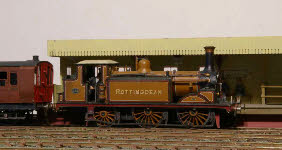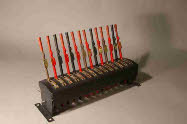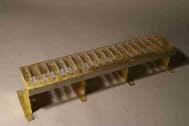



November 2012. Trackwork proceeds apace, and three out of four boards are virtually complete – nearly all Chris’s work. Functional chairs are being glued in place as we progress, but there will be a lot of work fixing the cosmetic [photo]chairs (to hide the rivets).
The ground frame lever frame is coming together very slowly. It really isn’t very good. The cast levers are perhaps the best available (rather than sweated together etched components) but the geometry of the frame is simply wrong, and the design is such that it will be very difficult to assemble. The design of the catchboxes is very poor – I’ll throw these away and scratchbuild something better.
My photos from Lens have arrived. I have some of them already, but these prints are large and good quality, so more detail shows. I have a second view of the station from the west, which shows a bit more detail of the missing building on the down platform. I’ve concluded that this is the original station building from when the line was opened. I’ve drawn the building as best I can from what I can see, and within a few days I have another building carcass awaiting painting and windows.
December 2012. Trackwork on all four boards is now almost complete apart from the last few switch rails and check rails. We need to check that all the functional chairs are properly glued down.
Once the trackwork is finished we need to think about tie-
 I’ve finally got the ground frame lever frame to first base -
I’ve finally got the ground frame lever frame to first base -Another walk with a camera and a tape measure, and I have the dimensions of the 1863 station building. A few more days and I have a drawing and then the walls of the building cut-
January 2013. Trackwork is now all in place, and we now have the task of grinding down the rivets so that the cosmetic chairs can be glued in place. This is not my favourite task, but we have at least minimised the effort required by maximising the use of functional chairs. With two of us working together we’ve managed to add the cosmetic chairs to two of the boards – so about 50% complete in a month.
 I’ve more or less finished the carcass of the lever frame for the main box (18 levers) by cutting and joining the 14 lever and 7 lever MSE frames, and adding a few scratchbuilt
I’ve more or less finished the carcass of the lever frame for the main box (18 levers) by cutting and joining the 14 lever and 7 lever MSE frames, and adding a few scratchbuilt  elements (quite a lot actually). I’ve also decided to build a small 4 lever frame for the locally operated points, mimicking the main lever frames, but without interlocking. The main outstanding bit is to redesign the catchboxes, and work out the final assembly.
elements (quite a lot actually). I’ve also decided to build a small 4 lever frame for the locally operated points, mimicking the main lever frames, but without interlocking. The main outstanding bit is to redesign the catchboxes, and work out the final assembly.I’ve sorted out the lifting tappets and sequential locking for the running signals which is all that’s stopped me making the signal box locking frame. Perhaps unnecessary, but I’ve included all the running signals in both directions (home, platform starter, advanced starter as well as distant) in the lever and locking frames, even though only three of these eight signals will be on the scenic section. The off-
 A few day’s work and the main box locking frame is complete and functional together with the locking bars between the two frames.
A few day’s work and the main box locking frame is complete and functional together with the locking bars between the two frames.All I have to do now is sort out the design for the catchboxes, and finish building the lever frames.
February 2013. We’re aiming to complete the addition of the functional chairs this month, which should be possible.
I’ve finally sorted out the catchbox design, so nearly there with lever frames.